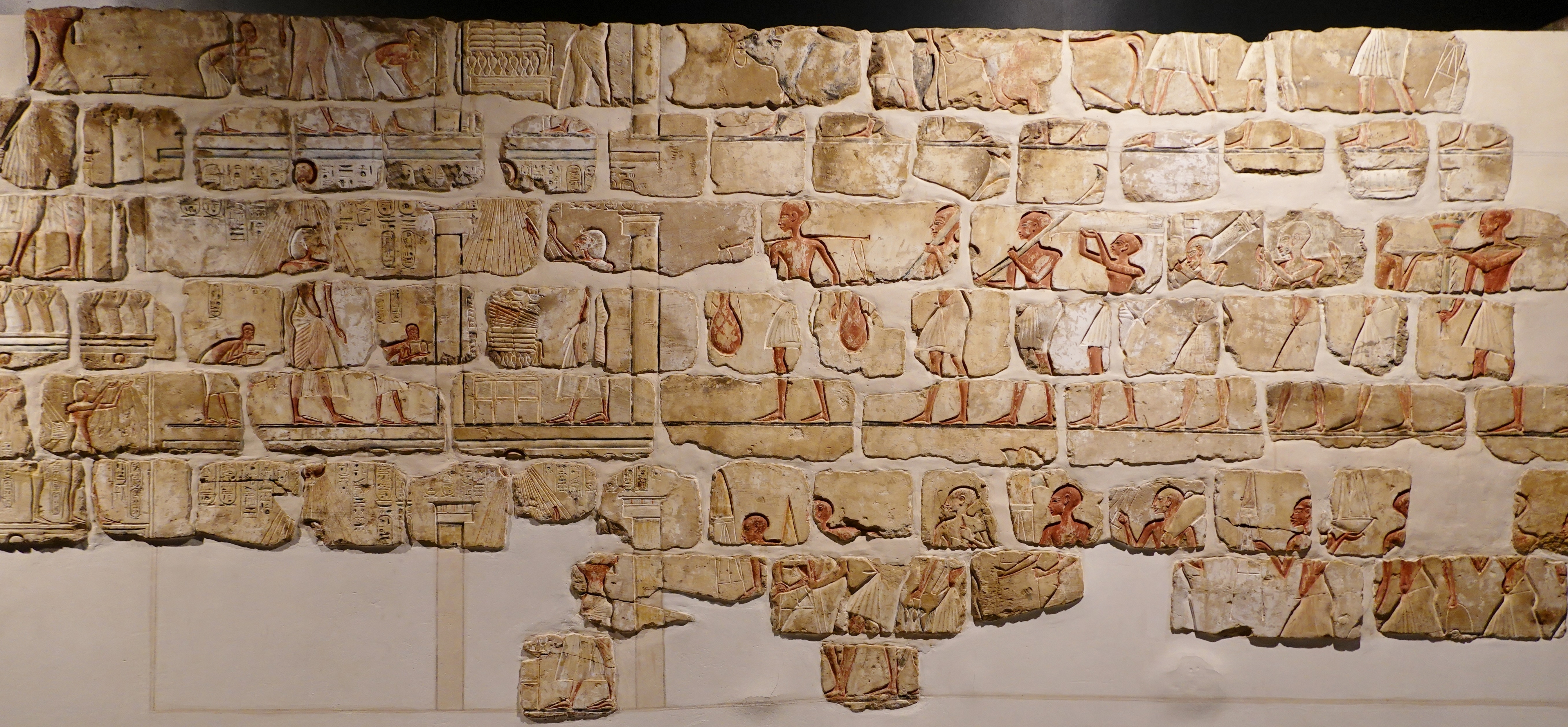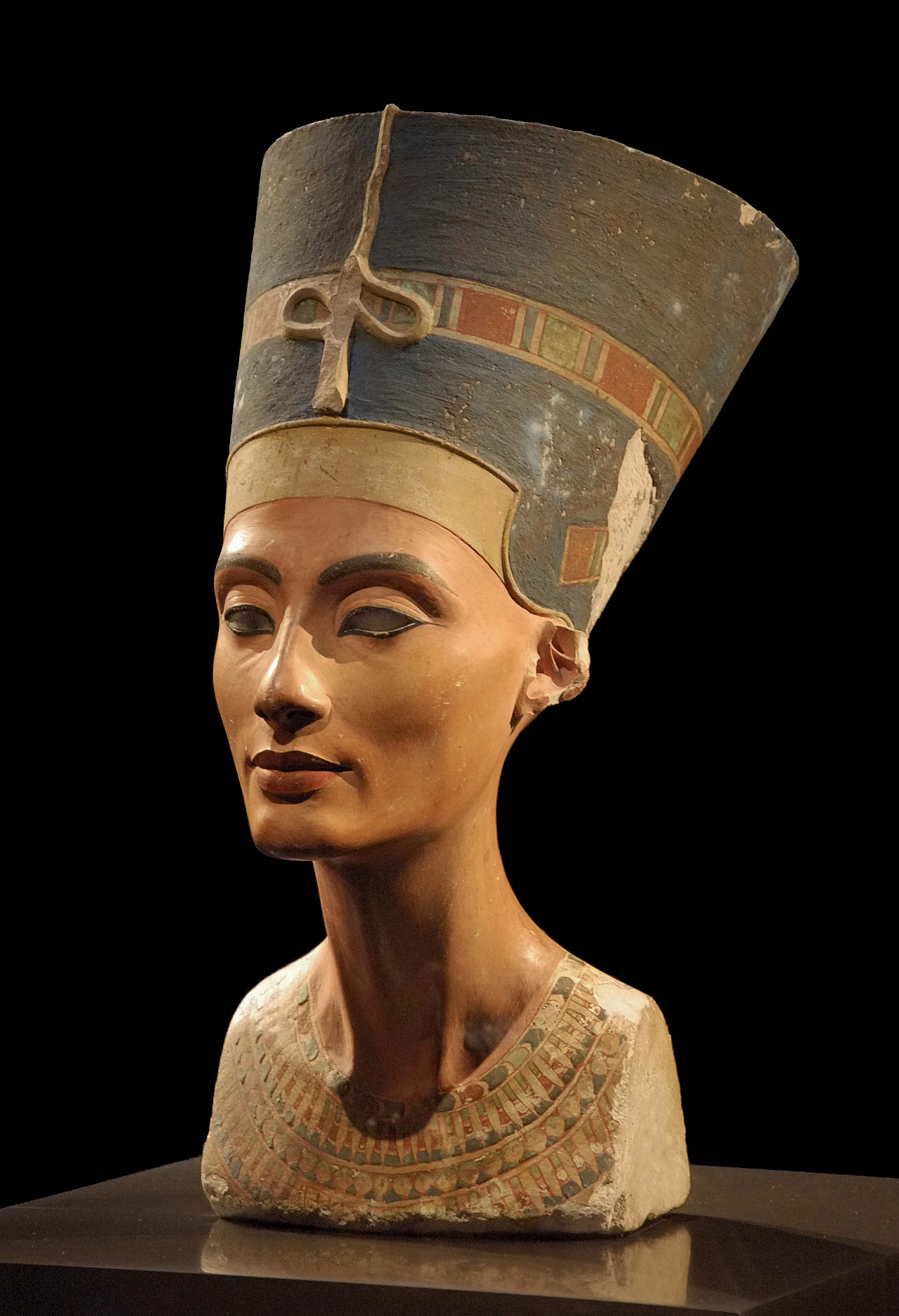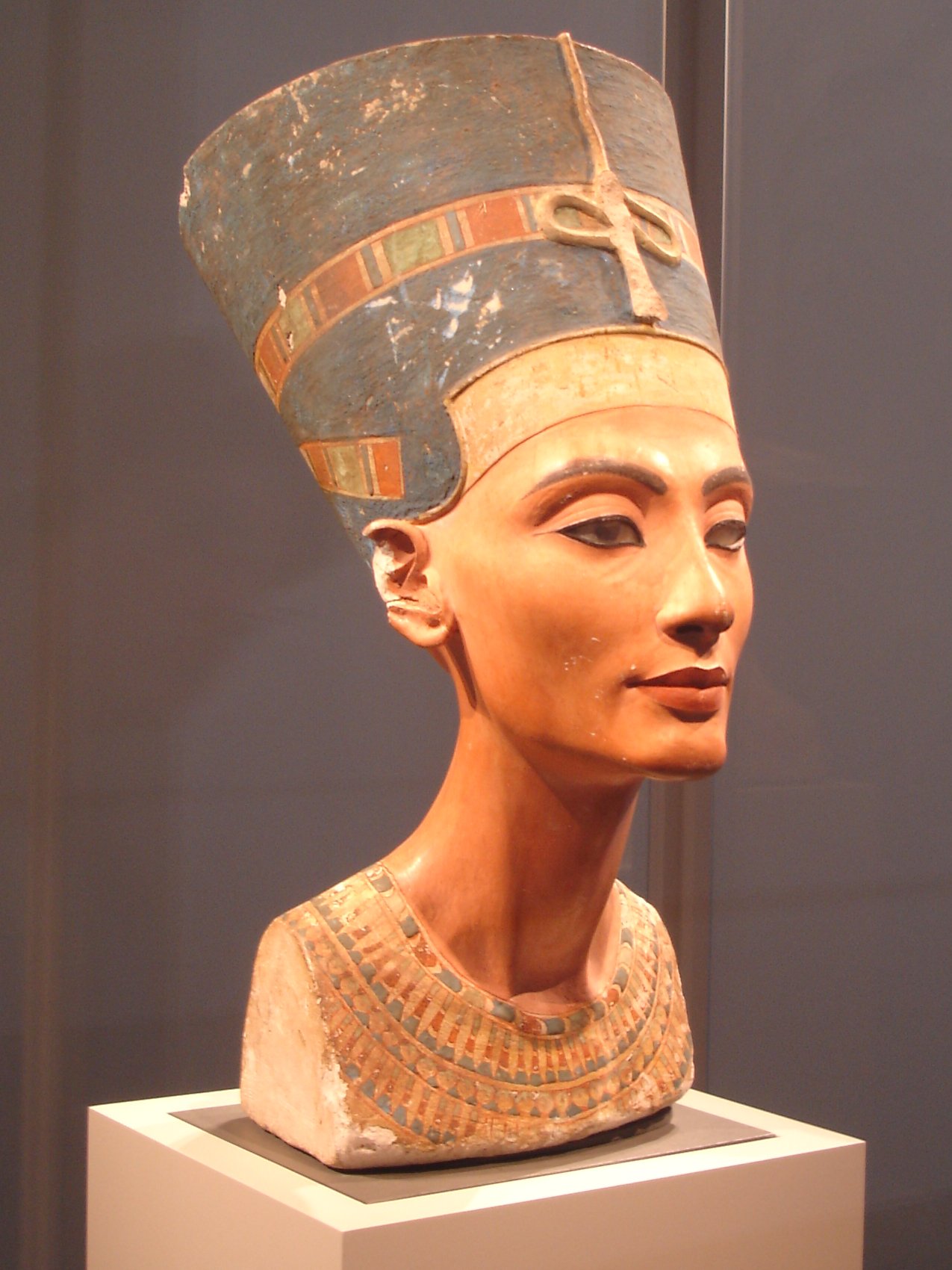|
Amarna Style
Amarna art, or the Amarna style, is a style adopted in the Amarna Period during and just after the reign of Akhenaten (r. 1351–1334 BC) in the late Eighteenth Dynasty, during the New Kingdom. Whereas Ancient Egyptian art was famously slow to change, the Amarna style was a significant and sudden break from its predecessors both in the style of depictions, especially of people, and the subject matter. The artistic shift appears to be related to the king's religious reforms centering on the monotheistic or monolatric worship of the Aten, the disc of the Sun, as giver of life. Like Akhenaten's religious reforms, his preferred art style was abandoned after the end of his reign. By the reign of Tutankhamun, both the pre-Amarna religion and art style had been restored. Background and history Shortly after taking the throne, Amenhotep IV adopted a policy of religious reform centering on the Aten. While it is not clear if he held that the Aten was the only god (monotheism), he clea ... [...More Info...] [...Related Items...] OR: [Wikipedia] [Google] [Baidu] |
Nefertiti Bust
The Nefertiti Bust is a painted stucco-coated limestone bust of Nefertiti, the Great Royal Wife of Egyptian pharaoh Akhenaten. The work is believed to have been crafted in by Thutmose because it was found in his workshop in Amarna, Egypt. It is one of the most-copied works of ancient Egypt. Nefertiti has become one of the most famous women of the ancient world and an icon of feminine beauty. A German archaeological team led by Ludwig Borchardt discovered the bust in 1912 in Thutmose's workshop. It has been kept at various locations in Germany since its discovery, including the cellar of a bank, a salt-mine in Merkers-Kieselbach, the Dahlem museum, the Egyptian Museum in Charlottenburg and the Altes Museum. It is currently on display at the Neues Museum in Berlin, where it was originally displayed before World War II. The Nefertiti bust has become a cultural symbol of Berlin as well as ancient Egypt. It has also been the subject of an intense argument between Egypt and Germany ... [...More Info...] [...Related Items...] OR: [Wikipedia] [Google] [Baidu] |
Talatat
Talatat are limestone blocks of standardized size (c. 27 by 27 by 54 cm, corresponding to by by 1 ancient Egyptian cubits) used during the 18th Dynasty reign of the Pharaoh Akhenaten in the building of the Aton temples at Karnak and Akhetaten (modern Amarna). The standardized size and their small weight made construction more efficient. Their use may have begun in the second year of Akhenaten's reign. After the Amarna Period talatat construction was abandoned, apparently not having withstood the test of time. Amenhotep IV talatats The blocks used in the Temple of Amenhotep IV in Karnak, and the other abandoned temples devoted to the deity Aten, were reused by Horemheb and Ramesses II as filler material for pylons and as foundations for large buildings. The Great Hypostyle Hall at Karnak is built on thousands of these blocks, as is the Second Pylon. Tens of thousands of the talatat have been recovered. The decorated stones are being photographed and the scenes they depic ... [...More Info...] [...Related Items...] OR: [Wikipedia] [Google] [Baidu] |
Sunk Relief
Relief is a sculptural method in which the sculpted pieces are bonded to a solid background of the same material. The term ''relief'' is from the Latin verb ''relevo'', to raise. To create a sculpture in relief is to give the impression that the sculpted material has been raised above the background plane. When a relief is carved into a flat surface of stone (relief sculpture) or wood (relief carving), the field is actually lowered, leaving the unsculpted areas seeming higher. The approach requires a lot of chiselling away of the background, which takes a long time. On the other hand, a relief saves forming the rear of a subject, and is less fragile and more securely fixed than a sculpture in the round, especially one of a standing figure where the ankles are a potential weak point, particularly in stone. In other materials such as metal, clay, plaster stucco, ceramics or papier-mâché the form can be simply added to or raised up from the background. Monumental bronze reliefs ... [...More Info...] [...Related Items...] OR: [Wikipedia] [Google] [Baidu] |
Metropolitan Museum Of Art
The Metropolitan Museum of Art of New York City, colloquially "the Met", is the largest art museum in the Americas. Its permanent collection contains over two million works, divided among 17 curatorial departments. The main building at 1000 Fifth Avenue, along the Museum Mile on the eastern edge of Central Park on Manhattan's Upper East Side, is by area one of the world's largest art museums. The first portion of the approximately building was built in 1880. A much smaller second location, The Cloisters at Fort Tryon Park in Upper Manhattan, contains an extensive collection of art, architecture, and artifacts from medieval Europe. The Metropolitan Museum of Art was founded in 1870 with its mission to bring art and art education to the American people. The museum's permanent collection consists of works of art from classical antiquity and ancient Egypt, paintings, and sculptures from nearly all the European masters, and an extensive collection of American and modern ... [...More Info...] [...Related Items...] OR: [Wikipedia] [Google] [Baidu] |
Cairo
Cairo ( ; ar, القاهرة, al-Qāhirah, ) is the capital of Egypt and its largest city, home to 10 million people. It is also part of the largest urban agglomeration in Africa, the Arab world and the Middle East: The Greater Cairo metropolitan area, with a population of 21.9 million, is the 12th-largest in the world by population. Cairo is associated with ancient Egypt, as the Giza pyramid complex and the ancient cities of Memphis and Heliopolis are located in its geographical area. Located near the Nile Delta, the city first developed as Fustat, a settlement founded after the Muslim conquest of Egypt in 640 next to an existing ancient Roman fortress, Babylon. Under the Fatimid dynasty a new city, ''al-Qāhirah'', was founded nearby in 969. It later superseded Fustat as the main urban centre during the Ayyubid and Mamluk periods (12th–16th centuries). Cairo has long been a centre of the region's political and cultural life, and is titled "the city of a thousand m ... [...More Info...] [...Related Items...] OR: [Wikipedia] [Google] [Baidu] |
Thutmose (sculptor)
Thutmose, also known as "The King's Favourite and Master of Works, the Sculptor Thutmose" (also spelled Djhutmose, Thutmosis, and Thutmes), was an Ancient Egyptian sculptor. He flourished around 1350 BC, and is thought to have been the official court sculptor of the Egyptian pharaoh Akhenaten in the latter part of his reign. A German archaeological expedition digging in Akhenaten's deserted city of Amarna, Akhetaten, known today as Amarna, found a ruined house and studio complex (labeled P47.1-3) in early December 1912; the building was identified as that of Thutmose based on an ivory Blinkers_(horse_tack), horse blinker found in a rubbish pit in the courtyard inscribed with his name and job title.#Reeves2005, Reeves. (2005) p. 157. Since it gave his occupation as "sculptor" and the building was clearly a sculpture workshop, the determination seemed logical and has proven to be accurate. Recovered works Among many other sculptural items recovered at the same time was the polychro ... [...More Info...] [...Related Items...] OR: [Wikipedia] [Google] [Baidu] |
Nefertiti Bust
The Nefertiti Bust is a painted stucco-coated limestone bust of Nefertiti, the Great Royal Wife of Egyptian pharaoh Akhenaten. The work is believed to have been crafted in by Thutmose because it was found in his workshop in Amarna, Egypt. It is one of the most-copied works of ancient Egypt. Nefertiti has become one of the most famous women of the ancient world and an icon of feminine beauty. A German archaeological team led by Ludwig Borchardt discovered the bust in 1912 in Thutmose's workshop. It has been kept at various locations in Germany since its discovery, including the cellar of a bank, a salt-mine in Merkers-Kieselbach, the Dahlem museum, the Egyptian Museum in Charlottenburg and the Altes Museum. It is currently on display at the Neues Museum in Berlin, where it was originally displayed before World War II. The Nefertiti bust has become a cultural symbol of Berlin as well as ancient Egypt. It has also been the subject of an intense argument between Egypt and Germany ... [...More Info...] [...Related Items...] OR: [Wikipedia] [Google] [Baidu] |
Ankh
Progressive ankylosis protein homolog (ANK ilosis H omolog) is a protein that in humans is encoded by the ''ANKH'' gene. This gene encodes a multipass transmembrane protein that is expressed in joints and other tissues and controls pyrophosphate levels in cultured cells. Mutation at the mouse 'progressive ankylosis' (ank) locus causes a generalized, progressive form of arthritis accompanied by mineral deposition, formation of bony outgrowths, and joint destruction. The human homolog is virtually identical to the mouse protein and ANKH-mediated control of pyrophosphate levels has been suggested as a possible mechanism regulating tissue calcification Calcification is the accumulation of calcium salts in a body tissue. It normally occurs in the formation of bone, but calcium can be deposited abnormally in soft tissue,Miller, J. D. Cardiovascular calcification: Orbicular origins. ''Nature Mat ... and susceptibility to arthritis in higher animals. References External linksGeneR ... [...More Info...] [...Related Items...] OR: [Wikipedia] [Google] [Baidu] |
Tutankhamun Exhibition
Exhibitions of artifacts from the tomb of Tutankhamun have been held at museums in several countries, notably the United Kingdom, Soviet Union, United States, Canada, Japan, and France. The artifacts had sparked widespread interest in ancient Egypt when they were discovered between 1922 and 1927, but most of them remained in the Egyptian Museum in Cairo until the 1960s, when they were first exhibited outside of Egypt. Because of these exhibitions, relics from the tomb of Tutankhamun are among the most travelled artifacts in the world. Probably the best-known tour was the ''Treasures of Tutankhamun'' from 1972 until 1981. Other exhibitions have included ''Tutankhamun Treasures'' in 1961 and 1967, ''Tutankhamen: The Golden Hereafter'' beginning in 2022 , ''Tutankhamun and the Golden Age of the Pharaohs'' beginning in 2005, and ''Tutankhamun: The Golden King and the Great Pharaohs'' in 2008. Permanent exhibitions include the ''Tutankhamun Exhibition'' in Dorchester, United King ... [...More Info...] [...Related Items...] OR: [Wikipedia] [Google] [Baidu] |
Nefertiti
Neferneferuaten Nefertiti () ( – c. 1330 BC) was a queen of the 18th Dynasty of Ancient Egypt, the great royal wife of Pharaoh Akhenaten. Nefertiti and her husband were known for a radical change in national religious policy, in which they promoted a form of proto-monotheism centred on the sun god Aten. With her husband, she reigned at what was arguably the wealthiest period of ancient Egyptian history. Some scholars believe that Nefertiti ruled briefly as Neferneferuaten after her husband's death and before the ascension of Tutankhamun, although this identification is a matter of ongoing debate.Dodson, Aidan, Amarna Sunset: ''Nefertiti, Tutankhamun, Ay, Horemheb, and the Egyptian Counter-Reformation''. The American University in Cairo Press. 2009, . If Nefertiti did rule as Pharaoh, her reign was marked by the fall of Amarna and relocation of the capital back to the traditional city of Thebes. She was made famous by her bust, now in Berlin's Neues Museum. The ... [...More Info...] [...Related Items...] OR: [Wikipedia] [Google] [Baidu] |
Colossal Statue Of King Amenhotep IV Akhenaten00 (3)
Colossal may refer to: * ''Colossal'' (film), a 2016 science fiction film starring Anne Hathaway * (Colossal) Pictures, entertainment company which closed in 2000 * Colossal (band), American punk band formed in 2001 * "Colossal", a song by Scale the Summit from the album '' The Collective'' * "Colossal", a song by Wolfmother from their debut album ''Wolfmother'' * Colossal (blog), art and visual culture blog * Colossal (chestnut), American chestnut cultivar * Colossal Biosciences, a biotechnology company See also * * * Colossal Connection, former professional wrestling tag team * Colossal Kongs The Colossal Kongs was a professional wrestling tag team who competed in the USWA, GWF and WCW. In WCW they were managed by Harley Race, who brought them to the promotion. The team was made up of Awesome Kong and Krusher Kong (Krusher Kong was ..., former professional wrestling tag team * Colossus (other) {{Disambiguation ... [...More Info...] [...Related Items...] OR: [Wikipedia] [Google] [Baidu] |






.jpg)
